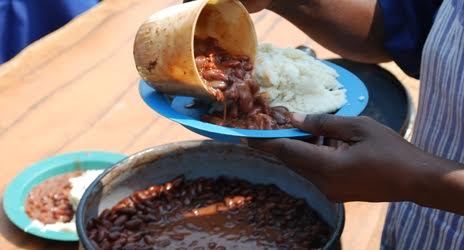Monsters ‘chew’ highways
The day is hot with temperatures at an average of 37 degrees Celsius. The sun’s rays are blinding, making it difficult for the small-framed David to get a proper view of where he is headed.
He sometimes bows to the majesty of the sun but tries to keep his beady eyes on the road.
Even expressions on the faces of cows grazing the lush green grass in fields along the road tell how much they “pity” the small driver. It will be a long time before he gets to Harare then proceed to Nyamapanda Border Post. His final destination is Mozambique, where he will collect rice for repackaging back home.
But despite the sun obstruction, David laughs with gusto and his small body looks too weak for the rocking laughter.
One of the female passengers jokes about how he would have been better off as a train driver – as he would not worry about potholes and too much sun and noisy passengers like her.
But as their discussion continues, one of the women makes an observation. She says the cargo he carries regularly could have been better off had it been ferried by rail. But unfortunately there is no rail line from Harare to Nyamapanda.
She explains that haulage trucks like David’s are one of the major reasons most highways that link Zimbabwe with other Sadc countries like South Africa, Mozambique, Botswana and Zambia, despite ageing, are in poor state.
She points out the demise of the National Railways of Zimbabwe could be one of the chief contributors to the burden roads carry.
In fact, she recalls, NRZ was once a vibrant entity whose operational inefficiency was worsened by theft and vandalism of railway infrastructure.
The three laugh off this reality as their journey continues. But there could be some grain of truth in the woman’s observations.
The demise of the NRZ, which used to ferry loads and loads of cargo across the country, has contributed to the bad state the country’s roads is in.
Most companies now transport their cargo by road and the numbers continue to increase daily.
But the companies complain that transporting cargo by road is both expensive and sometimes more risky than by rail.
They also fear the increase in the cargo loads ferried on already bad roads everyday continues to wear them out and may be difficult to repair in future.
Could their fears be true?
Zimbabwe National Roads Authority corporate communications executive Mr Augustine Moyo says there is a limit in terms what Zimbabwe’s roads can carry.
Mr Moyo revealed that statistics obtained from the Vehicle Inspection Deport show that each month 25 100 haulage trucks ranging from 30 to 56 tonnes enter the country through the Beitbridge Border Post.
Another 9 015 haulage trucks use the Chirundu Border Post each month with 6 300 using the Mutare entry point.
Victoria Falls Border Post records 2 742 haulage trucks entering Zimbabwe per month.
Nyamapanda Border Post has 2 700 entries per month and Plumtree 1 020.
“The roads we have were never designed for such loads.
“The issue of heavy loads being moved on our road network instead of rail cannot be overemphasised.
“A lot of cargo both for the domestic market and that in transit is exerting pressure on the road network.
“At the end of the day, goods moved by road tend to be very expensive for the end user as opposed to rail,” he said.
He said most of the country’s road network needs rehabilitation.
Mr Moyo added that currently, cargo that is being moved by road is causing enormous damage to the road network emphasising that this is reducing the lifespan of roads.
“When designing the roads, growth is anticipated but presently, that growth has been overtaken by the increased use of road as opposed to rail, in particular cargo that is moved by road,” he pointed out.
Zimbabwean motorists, Mr Moyo pointed out, have to appreciate that the country’s road network is very old and its lifespan is 20 years.
“When we attained independence, we inherited a dead road network. Thirty-two years after independence, we are still using the same roads and as Zinara, we are, just like our motorists, not happy with the present state of the roads.
“Since 2000, there has not been any significant investment in infrastructure in Zimbabwe. Taking into cognisance sanctions and what the economy has gone through in the last 12 years, Zinara, since dollarisation, has been working hard to ensure that road authorities are allocated money from the Road Fund for routine maintenance.
“There is a misconception in the market that Zinara is not fixing the roads.
“Zinara’s role is the management, control, allocation and disbursement of money collected from the Road Fund. Sources of revenue that go into the Road Fund are from toll fees, vehicle licence fees, road transit fees, fuel levy, abnormal load fees and loans and grants. The money is disbursed to local authorities among others,” he said.
He pointed out that funds collected are not adequate to address the defects on the roads as the country’s road network has not been maintained in the past 10 years.
“Zimbabwe has also suffered from brain drain as in most road authorities, skilled workers have left the
country.
“There is also the challenge of equipment to maintain the roads that is used by road authorities. The available equipment in the country is from private players and it tends to be very costly to hire for most road authorities,” he said.
This year, according to Mr Moyo, Zinara budgeted US$27 million for routine maintenance, which is for grass cutting and pothole patching.
“There is no expansion of the road network as such. What is happening presently is rehabilitation of some of roads.
“Examples of expansion are the Harare-Norton road and Harare city to Mbudzi roundabout.
“Those are projects that began before the economy faced challenges of hyperinflation and sanctions. Since dollarisation, road authorities are working flat out to clear those expansion projects before new ones can be taken up,” he added.
Mr Moyo said Zinara last year signed a US$206 million deal with the Development Bank of Southern Africa, which resulted in a joint venture company with Group 5 of South Africa called Infralink.
Under the deal, Infralink will rehabilitate the Plumtree to Mutare highway and there is progress on that project.
“By rehabilitation, we mean the road will be expanded to include shoulders and have yellow lanes, state-of-the- art tollgates like the ones you find in South Africa.
“Motorists must not confuse rehabilitation of the Plumtree to Mutare highway with dualisation.
“The motoring public needs to understand that there is a backlog as far as maintaining the road network is concerned and we need to clear that backlog before we can expand,” he revealed.
The Infralink deal is the largest single major investment in infrastructural development for one project in the past 12 years.
“As, Zinara we are grateful for the support for this deal that we received from the Minister of Transport, Communications and Infrastructure Development, Honourable Nicholas Goche, and the Zinara board, without whose support this deal would not be where it is today,” he said.
University of Zimbabwe lecturer in the Rural and Urban Planning Department Mr Nyasha Mutsindikwa recently said roads could take a certain amount of load and the inability to resuscitate the NRZ would continue putting a lot of pressure.
He said the possible solution is to come up with a transport infrastructure plan where all modes of transport are planned to come up with a master plan for the transportation system.
He also said there is need to channel resources towards the construction of the railway system, which is down so that everything functions and no pressure is put on roads.
City of Harare councillor and town planning expert Dr Sasha Jogi says resuscitating the NRZ will certainly take off the heavy burden on the country’s road network.
“It is important to understand that road systems provides flexibility which rail does not. The delivery is more direct and efficient on road as people get their cargo on their doorsteps. But, the damage this creates is worrying,” he said.
He said the problem is not only restricted to vehicles carrying cargo but spreads to those carrying passengers.
On the passenger side, Dr Jogi said, there is a lot of travel by commuters who use commuter omnibuses which carry fewer people.
As a result, he said, there is more road traffic than there should be thereby also putting pressure on road infrastructure.
He said the resuscitation of the NRZ would see the parastatal hopefully carrying on with the Harare-Chitungwiza railway project which failed to take off.
“At some stage they were looking at building the Chitungwiza railway line. It would have decreased road traffic. We need a rail system that goes around they city. The Harare to Chitungwiza railway line was just phase one as there were plans to expand to Norton, Bindura and Marondera among others,” he explained.
He pointed out that while working towards easing the pressure on roads, there is need to increase buses, which carry more people.
Dr Jogi warns: “We are already late. We should have these things in place.”
While the progress in the rehabilitation and expansion of the road network has been slow leading to a further deterioration of the roads, nothing much has been done to resuscitate the ailing NRZ.
With an extensive and wide rail network, stretching over 2 760 kilometres, the NRZ serviced the country and beyond borders without fail in the past.
It has an established rail system that enables the country to develop its export markets, through lines to the eastern Mozambique ports of Beira and Maputo, to the south linking with Botswana Railways and South African Railways (Spoornet) and to the north linking with Zambia Railways and the DRC, Angola and Tanzania. Hopefully one day, the NRZ will wake up from its slumber and reclaim its place in the transport industry.
l Feedback: [email protected]







Comments